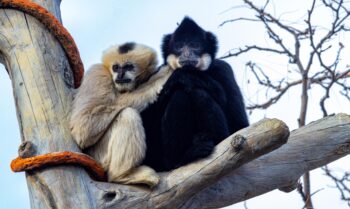April 18, 2019
Saving Wildlife Over a Warm Cup of Butter Tea
Denver Zoo’s Field Conservation Team Spent the Winter on the Mongolian Steppe Learning from Nomadic Herders
By Erica Garroutte, Field Conservation Community Engagement Manager
Winter on the Steppe and the Warmth of the Ger (Yurt)
Roughly 150 herding families live within Ikh Nart Nature Reserve in southeastern Mongolia, moving their gers (yurts) seasonally in pursuit of green pasture for their herds of cattle, camels, sheep, horses and cashmere goats. With temperatures reaching -40F in the winter, families stay warm by insulating their gers with thick layers of felt, keeping their stoves going all day and drinking lots of warm salted tea doctored with homemade butter. After the cold winter, families move to their spring ger locations when lambing season begins.
Applying centuries of traditional knowledge, they’ve managed to uphold their traditional lifestyles under the Gobi Steppe’s extreme conditions. Deeply in tune with the climate and variations in pasture in this landscape, herders are a wealth of knowledge, and any attempts to conserve the wildlife and ecosystem of Ikh Nart must include their perspectives and needs.
Understanding the Perspectives of Nomadic Herding Communities
Conservation efforts can’t stop just because temperatures drop. Our field conservation team continues their efforts to engage herders in our conservation efforts in Mongolia—even in such frigid conditions. We’ve worked with local communities for over 20 years at Ikh Nart, but we’re taking it to a whole new level under our new strategy. This winter, Denver Zoo’s Gana Wingard, Mongolia Program Director, and Erica Garroutte, Community Engagement Manager, traveled to Mongolia to brave the cold to engage herder families in our rangeland management work.
Led by our Community Engagement Specialist, Rentsen “Remo” Oyunbat, the team spent the winter traveling from ger to ger interviewing families. Sprinkled throughout the landscape, each ger was between five and 20 miles from the next, and visits lasted anywhere between 20 and 45 minutes.
Over a warm cup of butter tea, our team chatted with community members about how they manage their herds of goats, sheep and other livestock; how the land’s water and vegetation have changed over time; and how they share these important resources with several rare and endangered wildlife species.
Using a technique called participatory mapping, Remo worked with each family to develop a unique physical representation of the ways they travel through and use the landscape and where and when they encounter wildlife.
Putting It All to Use for People and Wildlife
Combining the results of these interviews and participatory mapping, researchers have a better understanding of how herders and wildlife use the land. In the coming year, Denver Zoo, Ikh Nart Park Administration and local partners will use this information to develop management strategies that maximize ecosystem benefits for both wildlife and the communities living within the reserve.
Through this inclusive process, we’re also building long-term local support for the conservation of important wildlife species, like argali sheep, cinereous vultures, goitered gazelle, and Siberian marmots, for future generations of herding families living in the Gobi steppe ecosystem.
Interested in experiencing Ikh Nart and DZ’s fieldwork first-hand? Join our team on a 2019 or 2020 conservation research expedition organized through Earthwatch!
Subscribe
Be among the first to hear the latest animal updates, important stories and details about all the fun happening around Denver Zoo.
Tags
-
 April 15, 2024
April 15, 2024Good Luck, Chuck!
Good Luck, Chuck! Beloved Bachelor Relocating as Part of Asian Elephant Species Survival Plan In a heartfelt and collaborative…
-
 April 15, 2024
April 15, 2024African Impact
African Impact Two New African Field Conservation ProgramsAim to Protect Gorillas + Grey Crowned Cranes We're honored to provide…
-
 March 1, 2024
March 1, 2024Last Place(s) on Earth
Last Place(s) on Earth New Asian Field Conservation Programs Protect Asian Elephants, Sumatran Orangutans + more Indonesia's Leuser Ecosystem…



